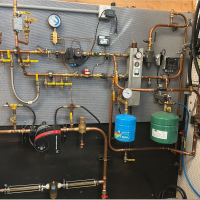Best Of
Re: Lochinvar WB80 not lighting, many new parts already. SOLVED
The gas valve, especially a new one, NEEDS adjustment. Unreal that any supposed "technician" would even think about walking away from this unit without doing a combustion analysis and adjustment. They need to come back and take care of that for FREE. There may also be something going on with the harness, but the gas valve is most definitely out of adjustment.
Re: New Steam Boiler Installed, Water Hammer, Prematurely Turns Off, Frustrated
@superdave17 said:
You all make me feel stupid but better financially.
Speaking as a fellow non-heating-pro, don't feel bad. I came here about 2 years ago knowing nothing about the hot water heating system in our 4-unit condo building, and the terrific people here spent a good deal of time teaching me from their wealth of knowledge. The stuff these guys know, and give away for free, is priceless.
What truly shocks me is how life-long professionals can offer $20k+ job selling $5,000 boilers + parts not knowing a single thing about physics or simple mathematics. I feel like a fool and I should have known better.
Again, don't feel bad. You are in the same boat as the millions of other homeowners who naturally assumed that the experienced heating pro with the license and the nice truck knew what he was doing. Unfortunately, your experience is a too-common occurrence. I've only been reading posts here for 2 years, and I'm amazed at the number of homeowners who post about problems with their new steam boilers, piped (or sized) totally wrong because the contractor didn't count up the radiator EDR or even read the manual. It is indeed unfortunate that there's isn't some "steam license" that HVAC contractors have to earn by proving that they can (1) add up radiator EDR and (2) read and follow a manual.
Re: grohe smart " stupid box"
I had trouble getting the weird threads to seal and customer service told me that threads like this are common in Europe as they use a fabric like, hemp sealing tape.
Re: Mitsubishi Mini Split - Vane stops swinging issue
manufacturers warranty do not cover labor unless they specifically say they do. I'm not sure how you think any installer would stay in business if they had to provide free service for over a decade on every unit they installed, they would need to charge 5 or more times the install cost I imagine
Re: Lochinvar WB80 not lighting, many new parts already. SOLVED
you absolutely must adjust the new gas valve with a combustion analyzer or it won't fire properly or likely at all.
probably could put the old gas valve back in and set the combustion properly and be on your way.
the readings on the manometer would be the result of the house regulator and the pipe sizing. there isn't anything really useful to measure pressure wise on the outlet side of the gas valve.
it would be easy enough to test for voltage at the gas valve to see if the harness is intact.
Re: Residential Steam Boiler Replacement - EDR Questions
As they say in Brooklyn, oei vei ( I think that the spelling may vary slightly, depending on which part of Brooklyn you are in). Definitely do not oversize. And even more importantly, don't hire someone who does not know how to size the boiler. Feel free to give me a buzz.
Re: Residential Steam Boiler Replacement - EDR Questions
The cast iron convector elements are similar to the ones I linked below sold today by OCS.
Your 28" ones are about 26 sq. ft. of EDR each.
Maybe someone can offer a more precise rating, but this should be a close estimate.
Re: Lochinvar NKC150N Water Temperature Problem
did you go through the maintenance steps in the manual?
There is a diverter valve that can get sticky from hard water deposits
 hot_rod
hot_rod
Re: grohe smart " stupid box"
 Intplm.
Intplm.
Re: Another Honeywell Heat Generator
or just keep it upright until you get some plugs in it


